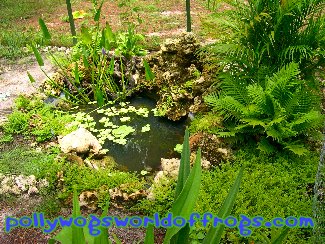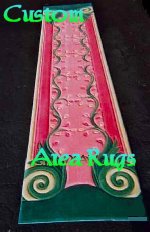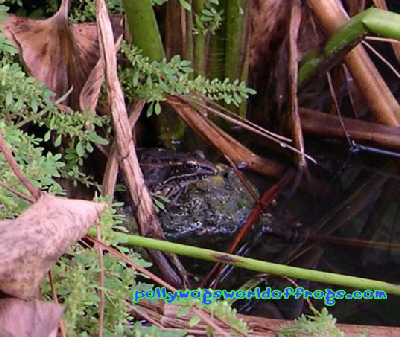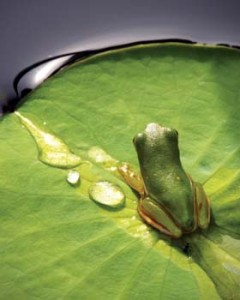Frog Conservation
Importation of wild frogs from foreign countries depletes the indigenous populations of frogs throughtout our world. Please be responsible when you purchase any frogs. Be sure that the animals are captive bred whenever possible, and come from clean, reputable stock. learn more about depletion of wild frog populations Here∼ Over Harvesting ∼
 Frog conservation is more important than ever. Since the early 80's, the world has begun to lose an alarming amount of her frog species, many to the point of extinction. Scientists are not yet sure if it's due to higher UVB rays from the sun, (you've heard of the hole in the ozone layer, right?) or disease, global warming, pollution from man, loss of habitat, or all of the above. I'm going to bet on the latter.
Frog conservation is more important than ever. Since the early 80's, the world has begun to lose an alarming amount of her frog species, many to the point of extinction. Scientists are not yet sure if it's due to higher UVB rays from the sun, (you've heard of the hole in the ozone layer, right?) or disease, global warming, pollution from man, loss of habitat, or all of the above. I'm going to bet on the latter.
With our help, we can at least help to slow this terrible tradgedy down!!! This page is dedicated to informing viewers of ways they (YOU & ME) can help along our anuran friends, using little effort but better judgement about things we do in our everyday lives.
As a sidenote, if you are unable to do much in the ways listed here, perhaps you'd consider donating something to Dr. Krieger? He's in charge of Save The Frogs. You can help him to continue his efforts to save our beloved amphibians. He doesn't even take a salary from this organization, so you can be assured your money is spent on the frogs and toads!
Make a Garden Pond
 The pond above resides in my side yard. My husband and I put it in this past spring. We already have both bufo terrestris and southern cricket frog tadpoles swimming gleefully around! If you have a yard, you can help out the local frogs and toads by doing the same. Many of their natural habitats are being destroyed, and a cool and inviting pond in spring will
help them reproduce, and help you get rid of pesky biting flies and mosquitoes; a frog's favorite diet.
The pond above resides in my side yard. My husband and I put it in this past spring. We already have both bufo terrestris and southern cricket frog tadpoles swimming gleefully around! If you have a yard, you can help out the local frogs and toads by doing the same. Many of their natural habitats are being destroyed, and a cool and inviting pond in spring will
help them reproduce, and help you get rid of pesky biting flies and mosquitoes; a frog's favorite diet.
It took us only about 35 minutes to dig the hole with a regular shovel, and only one of us shoveling at a time. We levelled the bottom of the kidney bean shaped hole, and dropped in the prefabricated 'pond'. Adding water a little at a time, to balance and weigh it down slowly, we were able to backfill in around the edges of the pond to insure that it stayed level.
The Pond water takes about 30 to 32 days to balance out. This is called The Run In Time. After that, the nitrifying bacteria have set up housekeeping, and the water clears and is good for animal life to enter.
The plants around the edge are all fast growers. We planned it that way. Remember, the little frog and toadlets will need hiding places when they emerge from the water's edge.
 You can smother the weeds in advance by placing out lawn bags that you've slit open to full size with scissors. Then spread them out over the desired garden area, and weight them down with stones. Overlap the edges. Within 3 months the weeds will be gone. Or perhaps you're lucky and already have grass in the space you'll be placing the pool!
You can smother the weeds in advance by placing out lawn bags that you've slit open to full size with scissors. Then spread them out over the desired garden area, and weight them down with stones. Overlap the edges. Within 3 months the weeds will be gone. Or perhaps you're lucky and already have grass in the space you'll be placing the pool!
Place out flowers that invite butterflies like Butterfly weed, Bee Balm, Butterfly orchids, Yarrow, English Lavendar, Sweet Pea, and Passion Flower and Mother Nature will thank you twice. Not only for the frogs, but the lovely butterflies that will wing their way through your enchanted pool garden. Birds will enjoy a quick bath at the pool's edge.
The Maypop, or Passion Flower vines are especially nice in that the scent wafts through the sultry summer air to find even your nose, as well as the butterflies. We love them, and even in northern climates to zone 4, with mulch protection in winter they survive to come back and flower again in spring.
Vernal Pools
 Vernal Pools are temporary, usually large puddles to small pools, that frogs and toads of some species use to lay their eggs in come springtime. They are found in forests and low lying areas. With Man taking over many tracts of lands, and draining areas that were once home to these pools, many species are threatened.
Vernal Pools are temporary, usually large puddles to small pools, that frogs and toads of some species use to lay their eggs in come springtime. They are found in forests and low lying areas. With Man taking over many tracts of lands, and draining areas that were once home to these pools, many species are threatened.
If you have a large enough yard, and can create (or already have) such an area, you may be able to help out some amphibians that without your help may not be able to reproduce! If you have a low lying pool area on a far corner of your yard and can spare it's use, please leave it for the frogs. If you have the space, you can dig (or have the kids do it) a shallow (about 2 feet) deep trench that is approximately 6 to 8 feet wide and 10 to 12 feet long. Place it in a partially shaded and protected area. Allow the native weeds and plants to grow near it's bank during the frog's breeding season and into the end of summer. This allows the froglets a place to hide until they become larger and can migrate safely to another space.
For more information on vernal pools, see the Links at page bottom.
Deck gardening ∼ Raising Gray Treefrog Tadpoles
Donna's Deck Garden
Donna and her wonderful Husband spent the time this past summer to take the time and concern to raise some Gray treefrogs on their deck. Please take the time to read and discover their secrets to taking a small group of frog's eggs to tiny froglets! The Nature is in Us is not only a lovely read, but something that those of us in smaller spaces can do to help our frogs!
Weed killers
Weed Killers are freaking out our frogs!
Weed killers have been studied extensively and found to 'feminize' male frogs, thus reducing the amount of male callers in spring when frogs generally reproduce. People need to become aware of this and stop the useage of the pesticides. I for one keep several kinds of gardens. Taking advice from fellow gardeners, a strong blast of water with your garden hose removes most pest/insects...and using this method will further protect our frogs and toads. Organic garden if possible. PLEASE click this link to further read the story:Science News & Frog Clues to how Weed Killer may Feminize Male Frogs
Pollutants
We pollute every day. Given, most of us don't do it intentionally, but changing just a few of our purchasing habits could change the lives of many of our native amphibians.
Instead of enamel paints, use latex water-based varieites for your painting projects. And use soap POWDER instead of the liquid types...those go into the waterways and wreak havoc on the frog's natural habitats. Instead of liquid clothes softeners, use the Bounce sheets in your dryer. Vinegar added to water will scrape that scummy splash off of your stove top, instead of using that harsh chemically based product most of us usually buy. As a matter of fact, vinegar, baking soda and citrus juice clean many things around our home wer'e not even aware of. Just changing a few of these mundane habits we've developed will help to clear up our waterways and invite back the pond life we remember.
Be careful using insecticides too! Frogs eat insects, so you putting out deadly sprays and poisons can ultimately damage the frogs. Scientists believe that these insecticides may damage the frog's reproductive systems, rendering them unable to reproduce! Please act responsibly when using chemicals on your lawn, and try whenever possible to 'go organic'.
According to Science Daily News and the scientists working on the article, 10 of our most common everyday insecticides may be killing our frogs off at alarming rates! To read more about it, see full article here: Science News, Low concentrates of Poisons and Frogs
For more help on alternative cleaning products, see the Links section at this page's bottom.
Properly Burying Dead Frogs & Toads
Dead Pets or frogs you've discovered in your yard can become a threat to the natural frog and toad populations. Chytrid is a fungal disease that scientists now know is responsible for the deaths of millions of frogs across the globe. America seems to be less threatened, but Scientists also think that this may be from under reporting or less research in North America. Ranavirus is also a threat to our wild amphibians, and is in North America.
Properly disposing of your pets or frogs and toads found on the lawn can help to arrest these maladies. To do your part, please read a writeup I've already created to address this issue: Funerals for Frogs
Make some Toad Homes
Toads need homes too! It's easy to create a few small spaces around your home for frogs and toads to set up residence. They will reward you by eating insect pests like mosquitoes, roaches, flies and root eating garden beetles.
Frog and Toad hiding places are as simple as carefully breaking old clay pots in half, and placing each half hollow-side down; in sheltered garden areas or near the home. Humid areas are the best. Near your outdoor garden hose is a good place. Where mulches are thick and you have a sprinkling system hooked up under a shade tree is also an ideal spot.
Stacks of stones that you set up for lawn-look enhancement is also a great hiding spot for frogs and toads. Just be sure that after you have them arranged the way you like, not to move them. It will disturb, and possibly kill; a hiding toad or frog.
Educate Our Children!
 We need to tell our children about everything we've learned about protecting our rich and diversified amphibians. Show them how to raise a bullfrog tadpole into an adult, and watch the morphing. It will enrich their minds, and teach them to respect the smallest of creatures.
We need to tell our children about everything we've learned about protecting our rich and diversified amphibians. Show them how to raise a bullfrog tadpole into an adult, and watch the morphing. It will enrich their minds, and teach them to respect the smallest of creatures.
Help them set up a vivarium for their morphed tadpole, and teach them what insects to feed it. Teach them which plants are best for their frog or toad, and how to take care of the water. Have them learn how to clean up the vivarium, and learn that the frog also needs a clean environment.
Take your child on fieldtrips, or sign him up for the appropriate trips at school. Talk with him or her about what they learned while there. Walk through the woods and point out all of the 'little things' that matter so much. Remember if you overturn a stone, to gently replace it. It is some small creature's home for sure
Show kindness and respect to all of the animals around you. As an adult and the child's parent, your appreciation and understanding of nature will instill the same belief system into them. Have them help you garden, or take them fishing, teaching them about the plants and animals you see while going to the fishing hole.
Teach your children to recycle. Have them help you when it's time to place an aluminum can or plastic bottle in the appropriate bin. Teach them about the natural cleaners we talked of earlier. Let them help you make up a batch of natural cleaner next time you're going to be doing so. Talk to them about why it is so important to be using them instead of chemicals. Children are much smarter than most of us give them credit for. Heck, I have very clear memories of things before I was 2 years old, and I'm pushing 50 now! No, they're not delusions, I just had a concious awarement at a very young age. I'm sure many many other children are the same.
Book Link
Here is a link to an excellent book for future naturalists: Jeff Corwin∼Your Backyard is Wild.
Online Teacher's Aid from Dr. Kreiger
World famous and serious scientist about saving our dwindling frog species, Dr. Kerry Krieger, has just released a beatifully photographed 125 page PDF file for teachers to use in the classroom to help educate childen about the basics of our frogs and other amphibians. I looked through every page, it's definitely going to get their attention. Easy to understand, and filled with colorful amphibians to catch the classroom's attention. Download at Save The Frogs or here is a direct link: Amphibian Teaching Guide.
Recycle∼Recycle∼Recycle!
Recycling is so important nowadays, as more and more of us become consumers on this wonderful planet. With the uprising of 1st world economies emerging in India and China, the two most humanly populated on earth; we have no choice. We can either wait and make it horrible for our children, or we can start to do it now and become a part of the solution.
In our House, we re-use the medium sized, thicker skinned clear water bottles that they sell the electrolyte drinks in. Our choice is PowerAide. The bottles last and last, I've had mine now for over 6 months. Water, juices and even Kool-Aid can't stop them!
We use cloth shopping bags. When I learned that albatross and seaturtles are ingesting the plastic bags from Walmart and other superstores and Shopping markets, I sat right down at my sewing machine and made up about 15 bags. I bought upholstery weight fabric at a dollar store, and sewed over the same seam three times to insure their strength.
We consciously avoid plastics as packaging materials whenever possible. If I see the same type of product on the store's shelf offered to me in cardboard, it becomes my choice. Make it yours too.
No Styrofoam! We used to buy a couple of styrofoam cup packages a week for our morning coffee, but no more. Now I re-use either the ceramic cups at home, or use the stainless steel coffee mug for the car. Styrofoam is horrible to the environment! And some animals think that it is food, and ingest it. This keeps them from being able to feed their own young, because their stomachs are bloated full of styrofoam and other plastic chips. AVOID STYROFOAM!!!
Helpful Links
For more on Vernal Pools, visit VernalPool.org
For Alternative Cleaning Products try visiting TheNewHomeMaker
Kill the bugs naturally! Try this link for insect repelling: EHow-Natural Insect Repellents
Natural Lawn and Plant Insect Repellants Get rid of lawn pests the natural way: gardenmandy.com. Don't forget this one: CleanAirGardening.com
Recycle at Home Here's a great starting link: Eartheasy.com
Another excellent recycling at home link: ThinkGreenFromHome.com
To Help Save Frogs through Research: savethefrogs.com is a study of passion for Dr. Kriger. He goes worldwide to save the frogs through his outstanding works, as well as his staff. They take no profits, only work to SAVE THE FROGS!!! Please click the above link, and donate any small amount to help him savethefrogs today.

